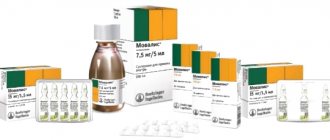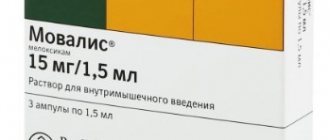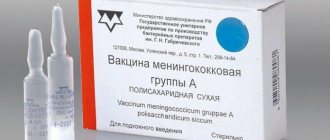Meloxicam is a non-steroidal anti-inflammatory drug with analgesic and antipyretic effects. It is used as injections (deep intramuscular), tablets (orally) and suppositories (rectally). The medicine is affordable and gives a quick effect. Used only in consultation with a doctor, dispensed from pharmacies with a prescription.
"Meloxicam" is a drug with the active ingredient of the same name. It is a non-steroidal anti-inflammatory drug. It has antipyretic, analgesic and analgesic effects.
Available in 3 dosage forms:
- solution in ampoules;
- pills;
- suppositories (candles).
The active component of Meloxicam is a derivative of organic enolic acid. It inhibits the activity of the enzyme cyclooxygenase-2 and slows down the formation of prostaglandins. As a result, inflammatory processes are stopped, the lesion is reduced, resulting in an analgesic effect.
The drug is released only with a prescription. It can be stored at room temperature (no more than 25 degrees) out of the reach of children. The shelf life is 2 years from the date of production.
Contraindications and side effects
The drug should not be used if there are such contraindications:
- intolerance to pyrazolone and its derivatives;
- allergic reactions, hypersensitivity to acetylsalicylic acid;
- recurrent nasal polyposis;
- severe kidney damage;
- peptic ulcers of the gastrointestinal tract;
- bronchial asthma;
- period of pregnancy, as well as lactation (at any stage);
- older people take the drug with caution.
Meloxicam suppositories are not allowed to be used in the presence of diseases of the rectum, anal region, if they are chronic. Other contraindications are possible, so be sure to consult a doctor before starting use.
In some cases, side effects are observed:
- exacerbation of stomach and intestinal ulcers;
- vomiting, nausea;
- belching;
- bloating;
- constipation;
- diarrhea syndrome;
- headaches;
- dizziness;
- drowsy state;
- leukopenia;
- anemia;
- increased blood pressure;
- skin rashes, itching, other forms of allergies;
- swelling;
- high urea level;
- blood rush to the chest, face, neck.
Meloxicam tablets: main characteristics
Meloxicam is a non-steroidal drug that has anti-inflammatory and antipyretic effects. It helps in eliminating pain and works as an analgesic. Available in 3 forms:
- Pills.
- Solution (in glass ampoules).
- Suppositories.
The active ingredient is meloxicam, a derivative of enolic acid. Dispensed only with a doctor's prescription. The drug is stored at room temperature (no more than 25 degrees) within the general shelf life (no more than 2 years).
Instructions for use of Meloxicam tablets and suppositories
Tablets are taken once a day in an amount of 7.5-15 mg with meals. This dosage is intended for adults and adolescents. In this case, the tablets can only be used for the first few days, after which it is possible to replace them with another drug.
If the patient is on hemodialysis and has severe kidney pathologies, he can use no more than 7.5 mg per day. However, daily and single dosages of other drugs in the same series (for example, Meloxicam Prana) may differ. The norm depends on the person’s age, condition, concomitant diseases and other factors.
Suppositories are administered rectally once a day - regardless of the time of day or meal. One suppository corresponds to a daily dosage of 15 mg.
Attention!
In case of overdose, the side effects described above may occur. Immediate gastric lavage is indicated; treatment is symptomatic. A specific antidote for Meloxicam has not been developed.
Meloxicam is an effective anti-inflammatory and pain reliever
One of the common anti-inflammatory drugs is meloxicam. Meloxicam belongs to the oxicam group.
Oxicams are a group of medications that are nonsteroidal anti-inflammatory drugs, or NSAIDs. Meloxicam is available in 7.5 mg tablets. Meloxicam is available in yellow tablets with a flat-cylindrical shape.
Meloxicam has anti-inflammatory, analgesic and antipyretic effects on the body. Basically, these effects are due to the effect on the enzyme cyclooxygenase. The anti-inflammatory effect of this drug has been tested on all standard biological models of inflammation.
With the development of inflammation, a large amount of prostaglandins (PGs) are released into the blood, which cause the main manifestations and symptoms. Meloxicam inhibits the action of PG. Two forms of the cyclooxygenase enzyme circulate in the human body: COX 1 and COX 2. COX 1 works constantly, COX 2 is activated only during inflammation. Meloxicam inhibits more COX2 in the body than COX1. Therefore, its use has far fewer side effects than other non-steroidal anti-inflammatory drugs. This fact has been proven during tests on various systems, both in laboratory conditions and in clinical trials. In addition, it was proven that greater blocking of COX-2 than COX-1 depended on the dosage of the drug.
When the drug is taken orally, meloxicam enters the bloodstream from the gastrointestinal tract. The maximum concentration of the substance occurs after 6 hours. The absorption of the drug is not affected by food or taking antacids.
Meloxicam, when entering the body, binds to proteins in the plasma, with 99% of the substance bound to albumin. In addition, it enters the synovial fluid of the joints, and the concentration of the substance is 50% of the concentration of the substance in the blood.
Meloxicam is processed in the liver, and 4 inactive components are synthesized. Isoenzymes such as CYP2C9 and CYP3A4 also play a major role in the deactivation process. Thanks to their work, two main metabolites are formed. The enzyme peroxidase is involved in the formation of two other inactive substances.
Meloxicam is removed from the body by the intestines and kidneys. The half-life of the drug takes about a day. In various liver diseases or liver failure, meloxicam is excreted from the body at the same rate. In case of renal failure, the rate of elimination increases significantly. If a patient is diagnosed with end-stage renal failure, there is a high concentration of the active substance in the blood, which requires adjustment of the dosage of the drug. In elderly patients, no significant differences in the pharmacokinetics of the drug were observed.
Meloxicam is prescribed as a symptomatic treatment for various joint diseases, such as osteoarthritis, rheumatoid arthritis, and spondylitis. In addition, the drug is taken to reduce pain and inflammation. At the same time, this drug does not affect the course of the disease.
When taking the drug, it is necessary to take into account a large number of contraindications, such as hypersensitivity to the drug, bronchial asthma, urticaria, nasal polyposis, as well as intolerance to aspirin and NSAIDs of other groups.
In addition, various diseases of the stomach and duodenum (erosions or ulcers), as well as inflammatory processes in the intestines, are also a contraindication for the use of meloxicam. Just as with the use of other NSAIDs, meloxicam is contraindicated in patients with various stages of renal and liver failure. In addition, severe heart disease, bleeding from various parts of the gastrointestinal tract, as well as diseases of the blood coagulation system are contraindications for meloxicam. Meloxicam should also not be taken during pregnancy at any stage or while breastfeeding.
When prescribing meloxicam, the doctor takes into account the patient’s concomitant pathology and, depending on the presence of any diseases, adjusts the dosage of the drug. To exclude the development of various complications from the gastrointestinal tract, the drug is prescribed in a minimum dosage, and the course of treatment is reduced as much as possible.
There are a large number of side or unwanted reactions when taking meloxicam. In this case, anemia, headache, emotional lability, tinnitus, various abdominal pains and other dyspeptic disorders can most often develop. Other possible complications are quite rare.
When taking other medications, it must be remembered that if the patient additionally takes other prostaglandin inhibitors, this may significantly increase the risk of developing ulcers and erosions of the gastrointestinal tract. In addition, simultaneous use of anticoagulants, thrombolytics and other drugs that affect hematopoiesis with meloxicam may increase the risk of bleeding.
It is also not recommended to take meloxicam together with methotrexate, lithium preparations, contraceptives and diuretics. The dosage of the drug is determined depending on the type of disease, stage of exacerbation and concomitant pathology. The drug is prescribed orally. Usually start with 7.5 mg per day, or, if the disease is in the acute stage, start with 15 mg per day and then reduce to 7.5 mg.
In case of overdose, the symptoms are nonspecific: vomiting, nausea, abdominal pain, renal and liver failure, and others. Treatment usually consists of gastric lavage, taking activated charcoal, and forced diuresis.
With long-term use of the drug, constant medical supervision is required, laboratory data and clinical symptoms should be assessed.
Meloxicam is a non-steroidal anti-inflammatory drug that causes fewer side effects than other drugs, but remains quite effective.
meloxicam pain reliever medicine pain reliever anti-inflammatory drug effective pain reliever effective anti-inflammatory drug
Drug interactions
Combined use with myelotoxic drugs increases the side effects of Meloxicam on the blood. If you take the drug together with non-steroidal anti-inflammatory medications, the risk of bleeding in the stomach and intestines, as well as exacerbation of ulcers, increases.
If you take Cholestyramine, the drug promotes the rapid elimination of Meloxicam. When using Heparin, Ticlopidine, drugs to lower blood pressure, and indirect anticoagulants, the risk of bleeding increases. When taken together with Cyclosporine, the likelihood of kidney-related side effects increases.
Special instructions for the use of Meloxicam-ratiopharm
Given the risks associated with the use of meloxicam, the duration of its use should be as short as possible, and the daily dose should be the minimum effective. Before starting treatment with meloxicam, it is necessary to undergo a course of treatment for esophagitis, gastritis, peptic ulcers of the stomach and duodenum (such patients may have a history of relapses during treatment with meloxicam). In patients with a history of gastrointestinal pathology, it is necessary to assess the condition of the digestive tract in order to detect gastrointestinal bleeding. As with the use of other NSAIDs, asymptomatic gastrointestinal bleeding or perforation, sometimes resulting in death, has been reported during treatment with meloxicam. In elderly people, gastrointestinal bleeding or gastrointestinal perforation is more severe. In such cases, treatment with meloxicam is discontinued. Severe life-threatening allergic reactions (such as anaphylactic reactions) may occur when using NSAIDs, including meloxicam. In this case, the use of meloxicam should be stopped immediately and appropriate treatment should be carried out. In isolated cases, NSAIDs can cause interstitial nephritis, glomerulonephritis, necrosis of the hepatic papillae, or nephrotic syndrome. A transient increase in liver function tests is noted. In most cases, these disorders are temporary. In case of persistent violation of these indicators, the use of meloxicam should be discontinued. By causing potassium, sodium and water retention, as well as interacting with diuretics, NSAIDs can worsen the condition of patients with heart failure or hypertension (arterial hypertension). The use of NSAIDs may cause decompensation of latent renal failure. Kidney function returns to normal after discontinuation of therapy. Use with caution in the elderly, with heart failure, liver cirrhosis or renal failure, as well as in patients using diuretics. When treating such patients, it is necessary to monitor diuresis and renal function. The effect of treatment should be regularly monitored, assessing the need for its continuation. Like other drugs that inhibit COX or prostaglandin synthesis, meloxicam may mask the symptoms of infectious diseases (such as fever). In some cases, the drug has a negative effect on reproductive function, so it is not recommended for women planning pregnancy. The tablets contain lactose, so the drug should not be prescribed to patients with hereditary lactose deficiency, galactosemia or glucose/galactose malabsorption syndrome. There is no data on the negative effect of meloxicam on the ability to drive vehicles or operate machinery. If there are disorders of the central nervous system (decreased visual acuity, increased fatigue, dizziness or other disorders), these types of activities are contraindicated.
Best before date
12 months
Vitamins with similar effects
- Maxiflorum with Valerian (Oral tablets)
- Amiton®-85%-Pro Sport (Powder)
- Antixinate (Dragee)
- Green Food (Oral Powder)
- Golden mustache. V. Ogarkov's drops No. 4 (Drops for oral administration)
- IMMUNOSTART Life formula (Lozenges)
The description of vitamin Milicar is intended for informational purposes only. Before starting to use any drug, it is recommended to consult a doctor and read the instructions for use. For more complete information, please refer to the manufacturer's instructions. Do not self-medicate; EUROLAB is not responsible for the consequences caused by the use of information posted on the portal. Any information on the project does not replace consultation with a specialist and cannot be a guarantee of the positive effect of the drug you use. The opinions of EUROLAB portal users may not coincide with the opinions of the site Administration.
Are you interested in Vitamin Milicar? Do you want to know more detailed information or do you need a doctor's examination? Or do you need an inspection? You can make an appointment with a doctor - the Euro lab is always at your service! The best doctors will examine you, advise you, provide the necessary assistance and make a diagnosis. You can also call a doctor at home . Euro lab clinic is open for you around the clock.
Attention! The information presented in the vitamins and dietary supplements section is intended for informational purposes and should not be a basis for self-medication. Some of the drugs have a number of contraindications. Patients need to consult a specialist!
If you are interested in any other vitamins, vitamin-mineral complexes or dietary supplements, their descriptions and instructions for use, their analogues, information about the composition and form of release, indications for use and side effects, methods of use, dosages and contraindications, notes about the prescription of the drug for children, newborns and pregnant women, price and consumer reviews, or you have any other questions and suggestions - write to us, we will definitely try to help you.





